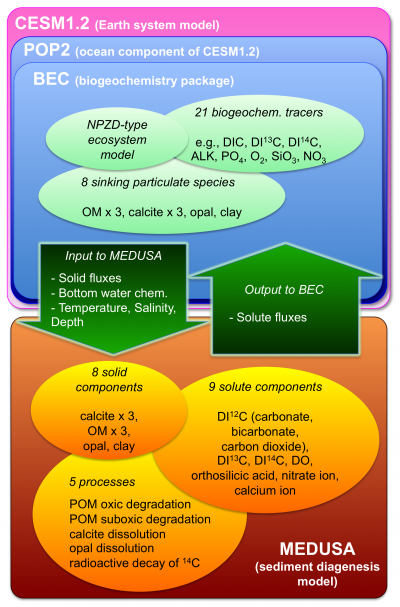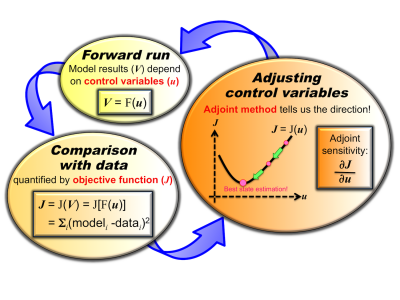- Wir über uns
- Alumni
- Ehemalige Mitarbeiterinnen und Mitarbeiter
- Kurahashi-Nakamura, Takasumi
Dr. Takasumi Kurahashi-Nakamura
Archived PageThis web page has not been updated since the former colleague left MARUM. |
CURRENT RESEARCH (for PalMod WG2)
Understanding the role of marine biogeochemical processes in the climate changes during the glacial-interglacial cycles (with CESM)
- Coupling of a sediment diagenesis model (MEDUSA) and an Earth system model (CESM1.2)
- The mechanism for the low CO2 level during the LGM
- The dynamics of marine carbon cycle in millennial-scale climate changes in MIS3
It is well known that carbon dioxide concentration (CO2 level) in the atmosphere has been increasing since the industrial revolution due to human’s CO2 emission. Our life in the future can suffer from climate changes induced by the increase in the CO2 level and/or from the CO2 increase itself (e.g., ocean acidification). To project the history of the CO2 level in the future, it is essential to understand the controlling mechanisms of the CO2 level in the climate system. The glacial-interglacial cycles in the last 100 kys are considered to be one of the most qualified research targets for that purpose, because they demonstrate historical (natural) climate changes with large variations in CO2 level.
It is widely considered that the marine carbon cycle would have had a large influence on the CO2-level variations in the glacial-interglacial cycles. However, the dynamics are not well-understood yet. We will tackle this issue by focusing on the budget of carbon and alkalinity in the ocean that crucially affects the chemical condition (i.e. pH) of the entire ocean, and thus the atmospheric CO2 level.

PREVIOUS RESEARCH (for the former Cluster of Excellence OC1)
Dynamical reconstruction of the global ocean state during the LGM (4D-VAR with MITgcm)
- LGM ocean reconstruction with an adjoint-based data assimilation technique
- Physics-based three-dimensional interpolation/extrapolation of existing paleoceanographic data
- More stratified LGM ocean with a stronger but shallower AMOC
We reconstructed the global ocean state for the modern age and for the Last Glacial Maximum (LGM) with a sophisticated data assimilation technique. A substantial amount of data such as seawater temperature and the isotopic composition of oxygen and carbon were integrated into an ocean general circulation model with the help of the adjoint method or 4D-VAR, thereby the model was optimized to reproduce plausible continuous fields of tracers, overturning circulation and water mass distributions. The reconstructed sea-surface temperature for the LGM shows a global-mean cooling of 2.2 K compared to the modern state.

EDUCATION
| 03/2004 | Ph.D. | "Evolution of the Surface Environment of Mars: Numerical Studies on the Climate System", Department of Earth and Planetary Science, University of Tokyo. |
| 03/2001 | M.Sc. | Department of Earth and Planetary Science, University of Tokyo. |
| 03/1999 | B.Sc. | Department of Geological Science, University of Tokyo. |
GENERAL INTEREST
Numerical modeling is an informative method that helps to describe, comprehend, and predict the behaviors of complex systems in a quantitative way. The consistent and general motive of my research is an interest in numerical modelling of natural phenomena, and of social phenomena as well.
In natural science, my main focus is on the climate stability (or variability) and the habitability of terrestrial planets, on the dynamics of the climate system, and on how to combine knowledge from numerical modeling and that from observation. In particular, I have been always interested in the carbon cycle of planets because it has a crucial influence on the amount of CO2 in the atmosphere that strongly affects the surface environment of them through the global energy balance.
In the field of social science, dynamics of people’s opinions in a society is a major concern, for example, from a political-science viewpoint because they govern how majorities are formed, how many majorities are created, and how stable they are. Analyzing social dynamics with a simplified numerical model will offer a beneficial insight to help our general understanding of phenomena based on plenty of well-controllable experiments. That will also provide fundamental ideas to design more realistic models for the projection into the future.
Specific research interests of mine includes/ included:
- Mechanisms to control the atmospheric CO2 level in the glacial-interglacial period
- The role of marine carbon cycles in climate changes in the past and future
- General understanding the behaviour of the climate system (e.g., intrinsic feedback mechanisms)
- Regulating mechanisms of the long-timescale evolution of climate of Mars
- Opnion dynamics with agent-based modelling
LIST OF PUBLICATIONS FOR NATURAL SCIENCE
Kurahashi-Nakamura, Takasumi, A. Paul, U. Merkel, and M. Schulz, "Glacial state of the global carbon cycle: time-slice simulations for the last glacial maximum with an Earth-system model", Clim. Past, 18, 1997–2019, https://doi.org/10.5194/cp-18-1997-2022, 2022.
Kurahashi-Nakamura, Takasumi, A. Paul, G. Munhoven, U. Merkel, and M. Schulz, "Coupling of a sediment diagenesis model (MEDUSA) and an Earth system model (CESM1.2): a contribution toward enhanced marine biogeochemical modelling and long-term climate simulations", Geosci. Model Dev., 13, 825–840, https://doi.org/10.5194/gmd-13-825-2020, 2020.
Breitkreuz, C., A. Paul, T. Kurahashi‐Nakamura, M. Losch, and M. Schulz, "A dynamical reconstruction of the global monthly‐mean oxygen isotopic composition of seawater", J. Geophys. Res. Oceans, https://doi.org/10.1029/2018JC014300, 2018.
Kurahashi-Nakamura, Takasumi, A. Paul, and M. Losch, "Dynamical reconstruction of the global ocean state during the Last Glacial Maximum", Paleoceanography, 32, doi:10.1002/2016PA003001, 2017.
Kurahashi-Nakamura, Takasumi, M. Losch, and A. Paul, "Can sparse proxy data constrain the strength of the Atlantic meridional overturning circulation?", Geosci. Model Dev., 7, 419-432, doi:10.5194/gmd-7-419-2014, 2014.
Kurahashi-Nakamura, Takasumi, A. Abe-Ouchi, and Y. Yamanaka, “Effects of physical changes in the ocean on atmospheric pCO2 during the last glacial maximum", Clim. Dyn., DOI10.1007/s00382-009-0609-5, 2010.
Kurahashi-Nakamura, Takasumi, A. Abe-Ouchi, Y. Yamanaka and K. Misumi, “Compound effects of Antarctic sea ice on atmospheric pCO2 change during glacial–interglacial cycle", Geophys. Res. Lett., 34, L20708, doi:10.1029/2007GL030898, 2007.
Kurahashi-Nakamura, Takasumi, and E. Tajika, “Atmospheric collapse and transport of carbon dioxide into the subsurface on early Mars”, Geophys. Res. Lett., 33, L18205, doi:10.1029/2006GL027170, 2006.
Kurahashi-Nakamura, Takasumi, and E. Tajika, “Evolution of the Martian climate: effects of the ice sheets”, Seppyo, Journal of the Japanese Society of Snow and Ice, Vol. 67, No. 2, pp.133-145, 2005 (in Japanese).
Nakamura, Takasumi, and E. Tajika, “Climate change of Mars-like planets due to obliquity variations: implications for Mars”, Geophys. Res. Lett., 30, No. 13, 1685, doi:10.1029/2002GL016725, 2003.
Nakamura, Takasumi, and E. Tajika, “Stability of the Martian climate system under the seasonal change condition of solar radiation”, Journal of Geophysical Research, vol.107, no.E11, 5094, doi:10.1029/2001JE001561, 2002.
Nakamura, Takasumi, and E. Tajika, “The Martian Climate System : Its Stability and Evolution”, Planetary People, Journal of the Japanese Society for Planetary Science, vol.10, no.4, pp.192-201, 2001 (in Japanese).
Nakamura, Takasumi, and E. Tajika, “Stability and evolution of the climate system of Mars”, Earth, Planets, and Space, vol.53, pp.851-859, 2001.
LIST OF PUBLICATIONS FOR SOCIAL SCIENCE
Lorenz, Jan, T. Kurahashi-Nakamura, and S. Shikano, "Cycles of public policy mood through opinion dynamics under heterogeneous bounds of confidence" (in prep.).
Kurahashi-Nakamura, Takasumi, M. Mäs, and J. Lorenz, "Robust clustering in generalized bounded confidence models", Journal of Artificial Societies and Social Simulation, 19, (4), 7, DOI:10.18564/jasss.3220, 2016.


